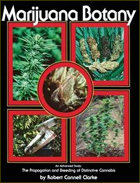
by Robert Connell Clarke
Seedling Traits
Seedling traits can be very useful in the efficient and purposeful selection of future parental stock. If accurate selection can be exercised on small seedlings, much larger populations can be grown for initial selection, as less space is required to raise small seedlings than mature plants. Whorled phyllotaxy and resistance to damping-off are two traits that may be selected just after emergence of the embryo from the soil. Early selection for vigor, hardiness, resistance, and general growth form may be made when the seedlings are from 30 to 90 centimeters (1 to 3 feet) tall. Leaf type, height, and branching are other criteria for early selection. These early-selected plants cannot be bred until they mature, but selection is the primary and most important step in plant improvement. Whorled phyllotaxy is associated with subsequent anomalies in the growth cycle (i.e., multiple leaflets and flattened or clubbed stems). Also, most whorled plants are staminate and whorled phyllotaxy may be sex-linked.

